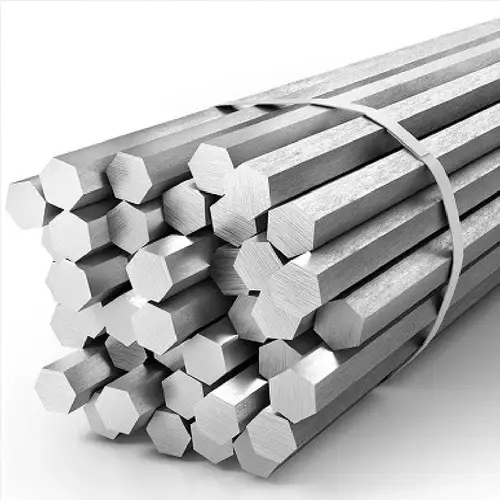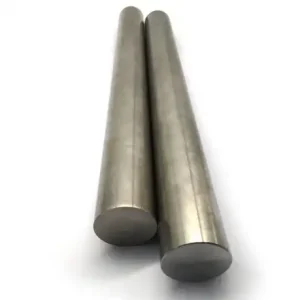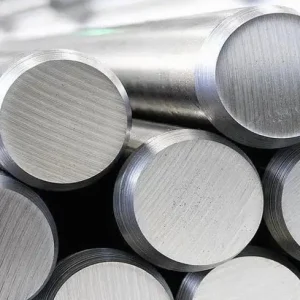347 stainless steel hex bar represents one of the most versatile and technically advanced austenitic stainless steel products available in today's industrial marketplace. This stabilized grade offers exceptional high-temperature performance, superior corrosion resistance, and remarkable structural integrity across demanding applications from aerospace to chemical processing. At MWalloys, our extensive experience with this premium material demonstrates its critical role in modern engineering solutions.
What is 347 Stainless Steel Hex Bar?
347 stainless steel hex bar is a stabilized austenitic chromium-nickel steel product manufactured in hexagonal cross-section geometry. This specialized configuration combines the inherent benefits of Type 347 stainless steel with the structural advantages of hex bar design.
The material belongs to the 300 series austenitic family, distinguished by its stabilization with columbium and tantalum additions. These stabilizing elements prevent carbide precipitation during high-temperature exposure, maintaining the steel's corrosion resistance and mechanical properties even after prolonged thermal cycling.
We manufacture these hex bars through precision hot rolling and cold finishing processes, ensuring dimensional accuracy and surface quality that meets stringent industrial standards. The hexagonal shape provides multiple flat surfaces for secure gripping, enhanced torque transmission, and simplified machining operations.
What is the Chemical Composition of 347 Stainless Steel Hex Bar?
The chemical composition of 347 stainless steel hex bar follows strictly controlled specifications that determine its performance characteristics:
| Element | Composition Range (%) |
|---|---|
| Carbon (C) | 0.08 max |
| Manganese (Mn) | 2.00 max |
| Phosphorus (P) | 0.045 max |
| Sulfur (S) | 0.030 max |
| Silicon (Si) | 1.00 max |
| Chromium (Cr) | 17.00 - 20.00 |
| Nickel (Ni) | 9.00 - 13.00 |
| Columbium + Tantalum | 10 x C min, 1.00 max |
| Iron (Fe) | Balance |
The stabilizing elements (columbium and tantalum) represent the defining characteristic of this grade. Their presence prevents sensitization by forming stable carbides instead of chromium carbides, maintaining corrosion resistance integrity.
What are the Mechanical Properties of 347 Stainless Steel Hex Bar?
The mechanical properties of 347 stainless steel hex bar demonstrate its exceptional performance capabilities:
| Property | Value | Test Method |
|---|---|---|
| Tensile Strength | 515 MPa (75 ksi) min | ASTM A370 |
| Yield Strength (0.2% offset) | 205 MPa (30 ksi) min | ASTM A370 |
| Elongation in 2 inches | 40% min | ASTM A370 |
| Hardness | 201 HB max | ASTM E18 |
| Modulus of Elasticity | 200 GPa (29 x 10⁶ psi) | ASTM E111 |
| Density | 8.0 g/cm³ | ASTM B311 |
These properties remain stable across extended temperature ranges, making 347 stainless steel hex bar suitable for applications involving thermal cycling and elevated operating temperatures.
What is the Specification of 347 Stainless Steel Hex Bar?
Our 347 stainless steel hex bars conform to multiple international specifications:
| Standard | Designation | Application |
|---|---|---|
| ASTM A479 | UNS S34700 | General engineering |
| ASTM A582 | Type 347 | Free-machining applications |
| ASTM A276 | 347 | Standard specification |
| DIN 1.4550 | X6CrNiNb18-10 | European standard |
| JIS SUS347 | SUS347 | Japanese industrial standard |
| EN 10088-3 | 1.4550 | European conformity |
Each specification defines specific requirements for chemistry, mechanical properties, dimensions, and testing procedures, ensuring consistent quality and performance across global markets.
What is 347 Stainless Steel Hex Bar Standard?
347 stainless steel hex bar manufacturing standards encompass comprehensive requirements for production, testing, and quality assurance. The primary governing standard is ASTM A479, which establishes specifications for stainless steel bars and shapes for pressure vessel construction.
This standard mandates specific heat treatment procedures, typically solution annealing at temperatures between 1900-2100°F (1040-1150°C), followed by rapid cooling. The cooling rate must be sufficient to prevent carbide precipitation while maintaining the austenitic microstructure.
Testing requirements include tensile testing, hardness verification, and corrosion resistance evaluation. Each production lot undergoes chemical analysis to verify composition compliance, ensuring the stabilizing elements meet specified ratios.
Quality control procedures involve dimensional inspection, surface examination, and non-destructive testing when required. We maintain comprehensive documentation for traceability and certification purposes.
What is the Equivalent of 347 Stainless Steel?
International equivalents to 347 stainless steel provide options for global sourcing and specification compliance. These grades share similar compositions and performance characteristics while conforming to different national standards.
The primary equivalents include European grade 1.4550 (X6CrNiNb18-10), Japanese SUS347, and various proprietary designations from major steel producers. Each equivalent maintains the essential stabilized austenitic characteristics while potentially showing minor compositional variations.
We recommend verifying specific requirements when substituting equivalent grades, as subtle differences in stabilizing element ratios or impurity levels can affect performance in critical applications.
What is the Difference Between 347 Stainless Steel and 304?
The fundamental differences between 347 and 304 stainless steel impact their respective application suitability:
| Characteristic | 347 Stainless Steel | 304 Stainless Steel |
|---|---|---|
| Stabilization | Columbium + Tantalum stabilized | Non-stabilized |
| High Temperature Performance | Excellent (up to 1500°F) | Limited (up to 1200°F) |
| Carbide Precipitation Resistance | Superior | Susceptible to sensitization |
| Weldability | Excellent without PWHT | Good with proper procedures |
| Cost | Higher due to stabilizing elements | Lower, standard grade |
| Corrosion Resistance | Enhanced at elevated temperatures | Good at moderate temperatures |
The stabilization in 347 grade prevents chromium carbide formation during elevated temperature exposure, maintaining corrosion resistance integrity where 304 would become sensitized.
What is a 347 Stainless Steel Hex Bar Used For?
347 stainless steel hex bar applications span numerous industries requiring high-temperature performance and corrosion resistance. The aerospace industry utilizes these bars for jet engine components, exhaust systems, and structural elements exposed to elevated temperatures.
Chemical processing facilities rely on 347 hex bars for reactor internals, heat exchangers, and piping systems handling corrosive media at elevated temperatures. The stabilized composition prevents intergranular corrosion in welded assemblies.
Power generation applications include superheater tubes, steam piping, and turbine components where thermal cycling and high-temperature operation demand stabilized stainless steel properties.
We supply 347 hex bars for fastener manufacturing, where the hexagonal geometry facilitates machining operations for specialized bolts, nuts, and threaded hardware requiring high-temperature service capability.
Food processing equipment manufacturers specify 347 hex bars for heated vessels, sterilization equipment, and components exposed to cleaning chemicals at elevated temperatures.
What is the Classification of 347 Stainless Steel Hex Bar?
The classification system for 347 stainless steel hex bar encompasses multiple organizational frameworks:
| Classification System | Category | Designation |
|---|---|---|
| UNS (Unified Numbering System) | Stainless Steel | S34700 |
| AISI (American Iron and Steel Institute) | Austenitic | Type 347 |
| Microstructure | Austenitic | Face-centered cubic |
| Magnetic Properties | Non-magnetic | In annealed condition |
| Corrosion Resistance | Excellent | General and high-temperature |
| Temperature Service | High-temperature | Up to 1500°F (816°C) |
This comprehensive classification enables precise specification and ensures appropriate material selection for specific application requirements.
347 Stainless Steel Hex Bar Global Market Prices 2025
Current global market pricing for 347 stainless steel hex bar reflects regional variations and market conditions:
| Region | Price Range (USD/kg) | Market Conditions | Supply Status |
|---|---|---|---|
| North America | $8.50 - $11.20 | Stable demand | Adequate supply |
| Europe | $9.20 - $12.50 | Strong industrial demand | Tight supply |
| Asia Pacific | $7.80 - $10.40 | Growing infrastructure needs | Expanding capacity |
| Middle East | $9.50 - $12.80 | Oil & gas projects driving demand | Import dependent |
| South America | $8.20 - $11.50 | Mining sector recovery | Limited local production |
These prices reflect current nickel costs, production capacity, and regional demand patterns. We recommend obtaining current quotations for specific requirements due to market volatility.
347 Stainless Steel Hex Bar Sizes and Weight Parameters
Standard size ranges and weight specifications for 347 stainless steel hex bar:
| Hex Size (inches) | Hex Size (mm) | Weight (lbs/ft) | Weight (kg/m) |
|---|---|---|---|
| 1/4 | 6.35 | 0.13 | 0.19 |
| 3/8 | 9.53 | 0.29 | 0.43 |
| 1/2 | 12.70 | 0.52 | 0.77 |
| 5/8 | 15.88 | 0.81 | 1.20 |
| 3/4 | 19.05 | 1.17 | 1.74 |
| 1 | 25.40 | 2.08 | 3.09 |
| 1-1/4 | 31.75 | 3.25 | 4.83 |
| 1-1/2 | 38.10 | 4.68 | 6.96 |
| 2 | 50.80 | 8.32 | 12.37 |
| 2-1/2 | 63.50 | 13.00 | 19.33 |
Custom sizes and lengths are available based on specific application requirements and minimum order quantities.
Advantages of 347 Stainless Steel Hex Bar
The primary advantages of 347 stainless steel hex bar make it indispensable for demanding applications. Superior high-temperature stability prevents property degradation during thermal cycling, maintaining structural integrity where standard grades would fail.
Excellent weldability without post-weld heat treatment reduces fabrication costs and complexity. The stabilized composition eliminates sensitization concerns in welded assemblies, ensuring long-term corrosion resistance.
Enhanced intergranular corrosion resistance provides reliable performance in aggressive chemical environments. This characteristic proves particularly valuable in process industries where conventional stainless steels show inadequate service life.
The hexagonal geometry offers multiple machining advantages, including secure workholding, improved cutting tool engagement, and reduced setup time. These benefits translate to lower manufacturing costs and improved production efficiency.
Dimensional stability under thermal stress prevents warping and distortion in high-temperature applications. This property ensures maintained tolerances and reliable assembly in precision applications.
Manufacturing Process
Our manufacturing process for 347 stainless steel hex bar begins with primary steelmaking using electric arc furnace technology. Raw materials including stainless steel scrap, ferro-alloys, and stabilizing elements undergo precise control to achieve target chemistry.
Secondary refining through argon oxygen decarburization removes impurities and adjusts final composition within specification limits. The stabilizing elements (columbium and tantalum) are added during this stage to ensure proper distribution.
Continuous casting produces billets with controlled solidification structure and minimal segregation. These billets undergo surface inspection and conditioning to remove any defects before subsequent processing.
Hot rolling at controlled temperatures forms the initial hex bar geometry while maintaining proper microstructure development. Multiple passes through specialized hex rolls ensure dimensional accuracy and surface quality.
Solution annealing at 1900-2100°F (1040-1150°C) dissolves any precipitates and homogenizes the microstructure. Rapid cooling prevents carbide precipitation while retaining the austenitic phase.
Final processing includes straightening, cutting to length, and surface finishing to meet customer specifications. Quality control testing verifies mechanical properties, chemistry, and dimensional conformance.
Nigerian Procurement Case Study
A major Nigerian petrochemical facility recently approached MWalloys for a critical application requiring 347 stainless steel hex bars. The project involved manufacturing specialized fasteners for a high-temperature reactor system operating at 750°C in a corrosive hydrogen sulfide environment.
The customer initially considered standard 316 stainless steel but recognized the risk of sensitization and subsequent corrosion failure. Our technical team recommended 347 grade based on the stabilized composition's superior high-temperature performance.
We supplied 2,500 kilograms of 347 stainless steel hex bar in various sizes from 12mm to 50mm hex, with lengths up to 6 meters. Each bar underwent individual certification including chemical analysis, mechanical testing, and dimensional verification.
The delivery timeline required careful coordination with Nigerian customs procedures and local logistics partners. Our established supply chain network ensured on-time delivery despite regional infrastructure challenges.
Post-installation monitoring confirmed excellent performance with no signs of corrosion or mechanical degradation after eighteen months of continuous operation. The customer has since specified 347 grade for similar applications across their facility expansion projects.
Frequently Asked Questions
Q1: Can 347 stainless steel hex bar be welded without special procedures?
Yes, 347 stainless steel hex bar can be welded using standard austenitic stainless steel procedures without requiring post-weld heat treatment. The stabilized composition prevents sensitization during welding thermal cycles. We recommend using 347 or 347L filler metals for optimal corrosion resistance matching.
Q2: What is the maximum service temperature for 347 stainless steel hex bar?
The maximum recommended service temperature is 1500°F (816°C) for continuous operation in oxidizing environments. Short-term exposure to higher temperatures may be acceptable depending on specific application conditions. Above 1600°F, scaling and property degradation become significant concerns.
Q3: How does 347 stainless steel hex bar perform in chloride environments?
347 stainless steel shows similar chloride corrosion resistance to other 300 series grades. While not immune to chloride pitting and crevice corrosion, it performs adequately in mild chloride exposures. For severe chloride environments, we recommend considering higher-alloy alternatives like 316L or super-austenitic grades.
Q4: What machining considerations apply to 347 stainless steel hex bar?
347 stainless steel work-hardens rapidly and requires proper cutting parameters to prevent tool damage. We recommend using sharp cutting tools, adequate coolant, and maintaining continuous feed rates. The hexagonal geometry provides excellent workholding capabilities, reducing vibration and improving surface finish.
Q5: Is 347 stainless steel hex bar available in metric sizes?
Yes, we manufacture 347 stainless steel hex bar in both imperial and metric sizing systems. Standard metric sizes include 6mm through 80mm hex with custom sizes available for specific applications. All metric products conform to applicable ISO and DIN specifications for dimensional tolerance and surface finish.
References
- ASTM A479 Standard Specification for Stainless Steel Bars and Shapes
- NIST Physical and Chemical Properties of Stainless Steels
- Wikipedia: SAE Steel Grades and Classifications
- ISO 683-17:2014 Heat-treatable steels, alloy steels and free-cutting steels
- Special Metals Corporation: Technical Properties of Stainless Steel Alloys





